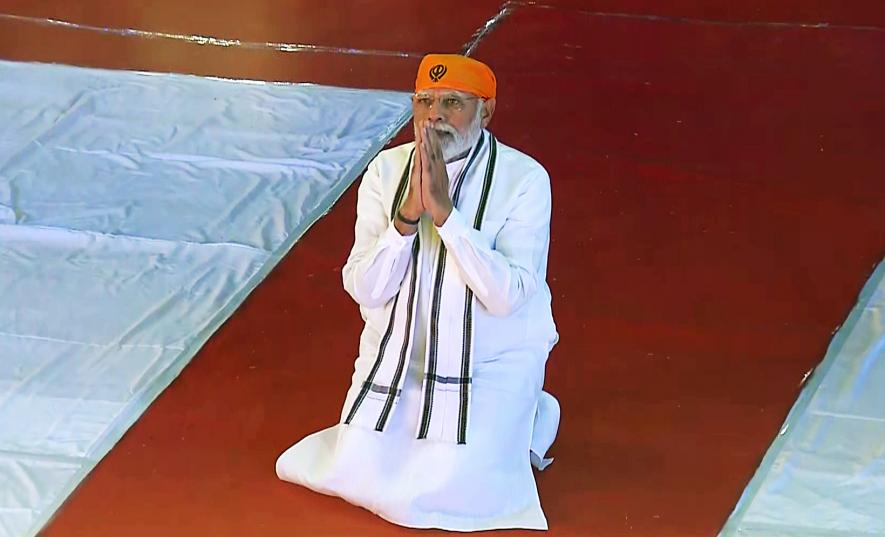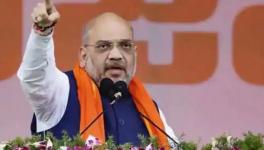Red Fort, Guru Purab, and Politics of Celebrating Sikh Faith

New Delhi, Apr 21 (ANI): Prime Minister Narendra Modi offers prayer to Sri Guru Teg Bahadur on his 400th Parkash Purab celebrations, at Red Fort in Delhi on Thursday. (
No prime minister of India can be compared with Prime Minister Narendra Modi in terms of the use of symbols and metaphors, and choice of occasions to address the nation. Two recent examples are the repeal of farm laws on the birthday of Guru Nanak Dev Ji and the speech celebrating the birth anniversary of Netaji Subhas Chandra Bose. We also see Modi use catchwords during his party’s election campaigns. The “shamshan ghat-kabristan” statement comes immediately to mind. Now, from the Red Fort, he has spoken on the birthday of the ninth Guru of the Sikhs, Guru Tegh Bahadur Ji.
The day is sacred for the Sikhs, and the Red Fort is almost permanently imprinted in the minds of the Sikhs as a symbol of the imperial power of the Mughal empire. In other words, it is a symbol of oppression, for it is from here that the Mughal Emperor Aurangzeb had ordered the execution of the ninth Guru in 1675. However, today, the Red Fort also represents the power of postcolonial India, from where prime ministers address the nation every year on 15 August, Independence Day.
Before analysing the Prime Minister’s speech on the auspicious day, it is essential to understand the ninth Sikh Guru and the crucial significance of his martyrdom for subsequent developments of the faith. Born on 21 April 1622 at Amritsar, he was the youngest of five sons of the sixth Sikh Guru, Hargobind Ji. His biographers record that he was tutored by Bhai Buddha and Bhai Gurdas, two highly respected Sikhs of his time. He had a mystical and contemplative strain, which later emerged in his poetry and conduct.
He was also a trained warrior and, at thirteen, participated in the battle of Kartarpur, after which the sixth Guru gave him the name “Tegh Bahadur”. However, the mystical strain and devotion to God dominated his subsequent life, and there is no evidence of his participation in any struggle to inherit the Gur Gaddi. Owing to his great qualities, personifying what being the Guru means, he became the ninth Guru after the eighth Guru, who had hinted where the next Guru—alluding to Guru Tegh Bahadur Ji—would be found, passed away in Delhi in 1664. Thereafter, the struggle to inherit the Gur Gaddi turned intense, and after an unsuccessful attempt on his life, he left Baba Bakala and moved to Patna—the birthplace of the tenth Guru. Finally, he settled at Anandpur Sahib, and in 1675, he was executed on the orders of emperor Aurangzeb.
The circumstances leading to this martyrdom have been viewed in different ways by scholars and historians, though it is a fact that Aurangzeb gave the order (fatwa) for his execution. The famous historian of Sikhism, Louis Fenech, writes in his book, Martyrdom in the Sikh Tradition, that though the fifth Guru was also martyred, it is the martyrdom of Guru Tegh Bahadur Ji that occupies the most important place in Sikh history. A possible reason, Fenech points out, is that it led to the creation of the Khalsa in 1699.
The causes leading to Guru Tegh Bahadur Ji’s martyrdom are shrouded in controversy—not for historians but due to the reasons given by the Sikh establishment for why it happened. If the establishment view is not strictly adhered to, or violated, it invites hostile reactions. This official explanation is that a delegation of Kashmiri Pandits reached Anandpur Sahib and narrated their plight of being forcibly converted to Islam. He rose to their rescue and ultimately was executed at Delhi on 11 November 1675.
This account of the Guru’s life is brief and by way of introducing his great personality as one who volunteered to sacrifice his life for not only what he believed but also for what others believed. The most notable aspect of the Sikh tradition is sacrificing one’s life without hatred and malice towards anyone. Thus, nowhere in the Guru period do we find that the Sikhs have identified Islam as the enemy. They clearly demarcated between the state and its apparatus on the one hand and people, irrespective of their religion, on the other. There are also numerous instances of the tenth Guru, Gobind Singh Ji, treating Hindus and Muslims equally.
In light of the above succinct historical account, the communication from the Union Culture Minister G. Kishan Reddy, as reported in The Indian Express newspaper on 19 April 2022, regarding the Prime Minister’s address to the nation on 21 April, is highly disturbing. Reddy said, “Guru Tegh Bahadur stood up to atrocities of the Mughals by protecting the freedom of Dharmic faiths. He fought for the rights of Sikh and Hindus. Despite being physically tortured by the Mughals for conversion, he stood his ground and chose to give away his life and not his belief system... He fought against forcible conversions of Kashmiri Pandits and this left the Mughals livid.” Then, on 20 April, Union Home Minister, Amit Shah, spoke to the Sikh Sangat. He virtually repeated what Reddy said, adding that the story of Sikh Gurus would be told to every child in India. He mentioned the plight of Kashmiri Pandits, who sought his help against Aurangzeb, and made it clear that the Guru sacrificed his life for Hindus and Sikhs.
Shah’s ten-minute speech was based on a construction of Sikh tradition on which all historians may not agree. This indicates the BJP is holding on to its old view of Sikhism and Sikhs as ‘protectors’ of the Hindu faith against the Muslims, whom it wants members of both faiths to view as a common enemy. This is something the Sikh Gurus never supported, despite the fact that Guru Tegh Bahadur sacrificed his life and the order to execute him came from the then emperor, Aurangzeb.
Now we come to the Prime Minister’s speech on 21 April. He spoke eloquently and according to the occasion. However, after accurately identifying the location of the ninth Guru in Sikh history, he mentioned how the Guru responded to “religious fanaticism”. He mentions Aurangzeb, though without indicating that he meant to target any religious community. However, a number of times, the Prime Minister and his party members have portrayed Aurangzeb as a cruel ruler, and charged their rivals with being pro-Muslim, and therefore pro-‘Aurangzeb’. This also means that he does not need to specifically mention Aurangzeb was a Muslim. He just needs to refer to religious fanaticism in the context of Aurangzeb, to send a message.
Further, the Prime Minister said the sacred book of the Sikhs, Sri Guru Granth Sahib, symbolises unity in diversity. He mentioned what his government has done for the religious sentiments of the Sikh community and related future plans. The most important thing to notice in the speech was the Prime Minister’s reference to the Citizenship Amendment Act, 2019. He said that as a result of it, the Sikhs displaced from Afghanistan after the Taliban took over, could be accommodated as citizens in India. However, Sikhs from Afghanistan could have been accommodated in India even without the CAA. After all, the new citizenship law excludes only Muslims, so it is a clear signal to divide the Sikh and Muslim communities, a division that has no sanction in Sikh tradition, which he was celebrating at Red Fort. The Prime Minister also did not forget to mention the reverence with which the sacred book of the Sikhs was brought to India from Afghanistan.
The speech of the Prime Minister could be seen in many ways, but two interpretations are possible. First, the purpose of this support for the birthday celebrations of the ninth Guru were to please the Sikh community in terms of votes, but this explanation seems out of place. The second interpretation could be that it was a reminder to the Sikhs that they should align with the majority community for their own benefit. This alternative interpretation seems more plausible in the sense that a community that is less than three per cent of the population of the country is not a force to reckon with in terms of votes, whereas the Sikhs have everything to gain if they align with the BJP.
The most important element of the celebration was that the government of India organised it in the place that symbolised the seat of power which gave the order to execute Guru Tegh Bahadur Ji—which the Prime Minister alluded to—in collaboration with the Delhi Gurdwara Management Committee. It is significant to have had this collaboration with the DGMC because it presents the Sikh establishment view of history, which BJP and the Prime Minister want to use in their own way, and for their own political purposes.
The author was a professor of sociology at Guru Nanak Dev University, Amritsar, and is a former president of the Indian Sociological Society. The views are personal.
Get the latest reports & analysis with people's perspective on Protests, movements & deep analytical videos, discussions of the current affairs in your Telegram app. Subscribe to NewsClick's Telegram channel & get Real-Time updates on stories, as they get published on our website.
























